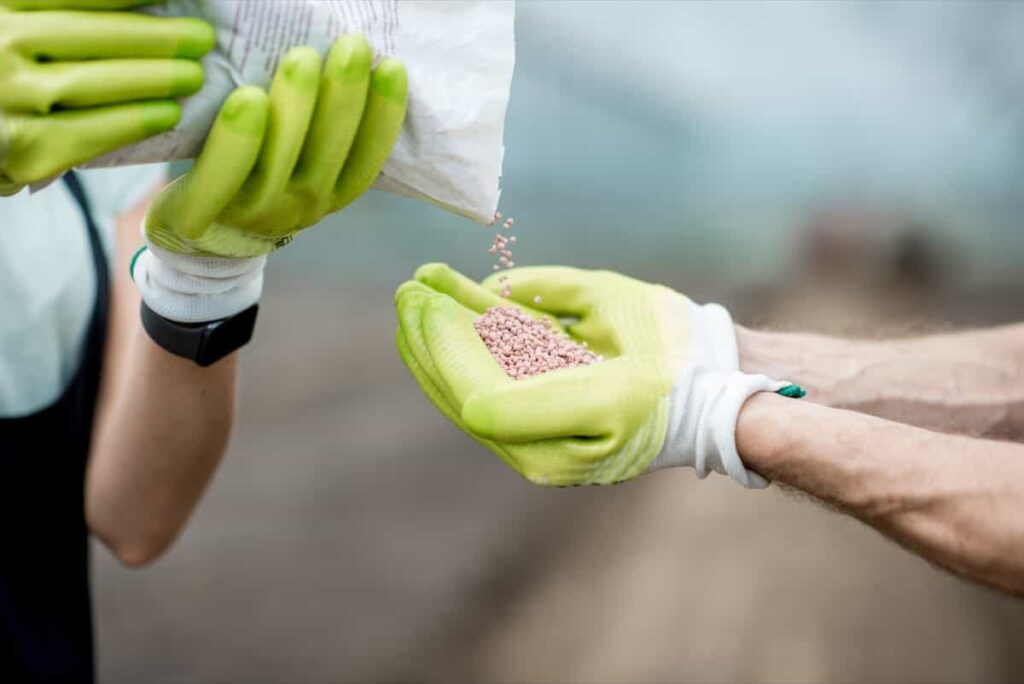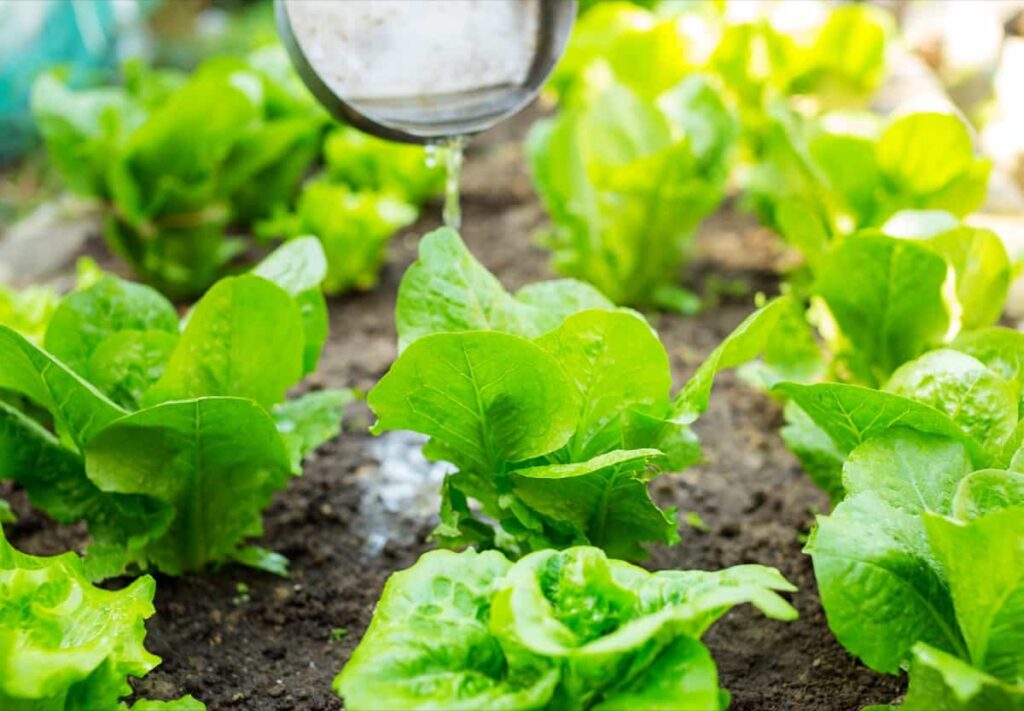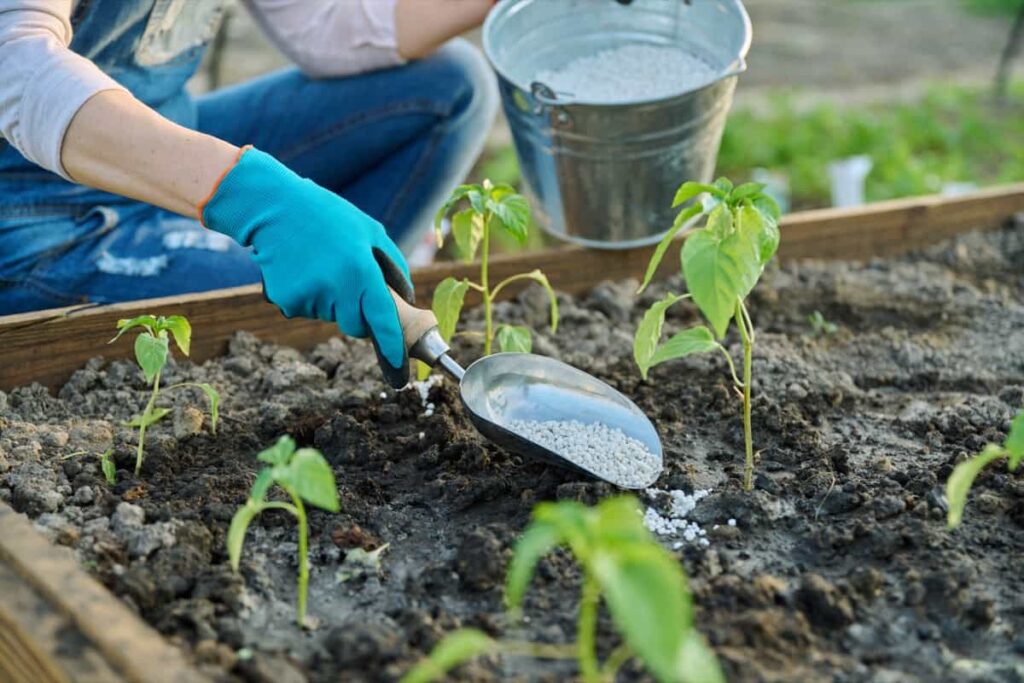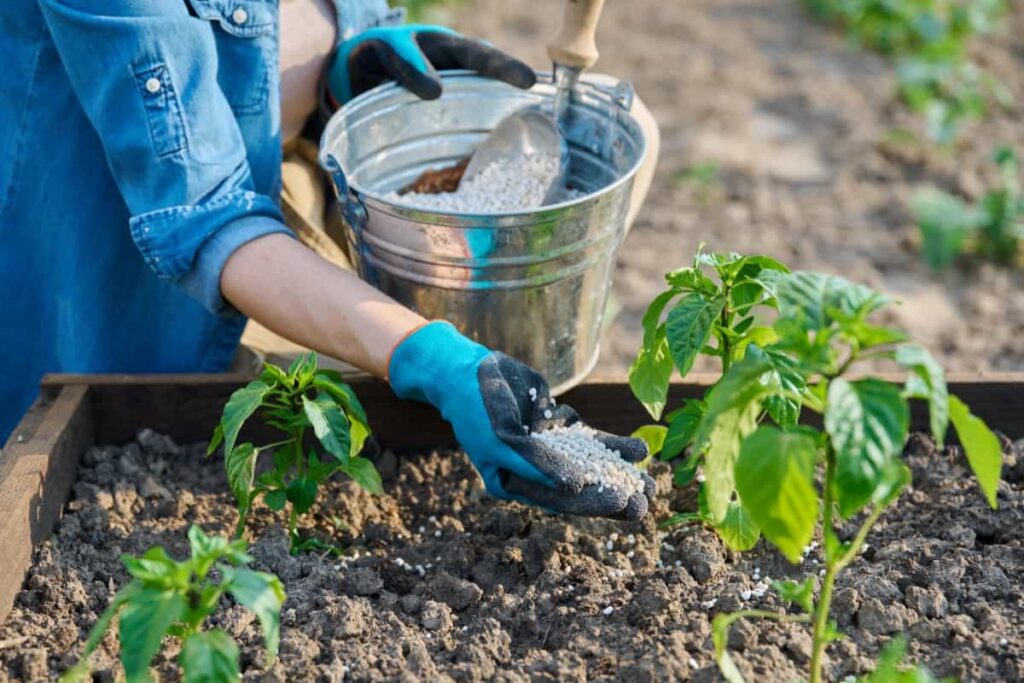Embarking on the journey of cultivating your vegetables is a rewarding endeavor, and understanding the nuanced nutritional needs of plants at various stages is crucial. Delving into DIY vegetable plant fertilizers unveils a fascinating world of tailored nutrition. Each growth phase demands a specific blend of nutrients from the delicate seedling stage to the bountiful harvest. In this exploration, we unravel the science behind customizing fertilizers, ensuring your plants thrive at every step of their botanical evolution.

DIY Vegetable Plants Fertilizers
Understanding the Nutrient Needs of Vegetable Plants at Different Growth Stages
Vegetable plants require specific nutrients at different growth stages to produce high-quality crops. During the sprout stage, the seed contains enough nutrients for germination and leaf production without additional fertilization. As the roots grow and spread, the plant needs a balanced supply of nitrogen, phosphorus, potassium, calcium, magnesium, and other micronutrients to support rapid growth. A well-composted soil or diluted liquid fertilizer can provide these nutrients.
During the vegetative stage, the plant focuses on producing more leaves. It stems, requiring a high amount of nitrogen for chlorophyll, amino acids, proteins, and enzymes involved in photosynthesis and cell division. A high-nitrogen fertilizer or organic sources like manure, blood meal, or alfalfa meal can boost vegetative growth. Phosphorus is for root development, seed formation, disease resistance, and pest prevention. A high-phosphorus fertilizer or organic sources like bone meal, rock phosphate, or fish meal can enhance the budding stage.
During flowering, the plant needs more potassium to produce and transport sugars and starches, regulate water balance, and improve protein synthesis and stress tolerance. A high-potassium fertilizer or organic sources like wood ash, kelp meal, or greensand can improve the flowering stage. In the ripening stage, the plant needs less nutrients and more water to mature its fruits or seeds.
Tailoring Homemade Fertilizers for Seedling Development in Vegetable Plants
Seedlings require a balanced and gentle fertilizer to support their growth and development. Homemade fertilizers can be tailored to meet the specific needs of different vegetable plants, using natural and organic materials. The benefits of using homemade fertilizers for seedlings include being cost-effective, environmentally friendly, and customizable to suit the gardener’s preferences and plant type. They can improve soil quality, structure, microbial activity, and diversity, enhancing plant health and resistance to pests and diseases.
In case you missed it: Easy Homemade Recipes for Garden Plants: Natural and Organic Fertilizer for Vegetables, Flowers, and Houseplants

Some common ingredients for homemade fertilizers for seedlings include compost, coffee grounds, eggshells, and banana peels. Compost is a rich source of organic humus and nutrients that improve soil fertility and water retention. Coffee grounds provide seedlings nitrogen, phosphorus, potassium, magnesium, and other trace elements, while eggshells supply calcium, magnesium, and other minerals. Eggshells can be crushed or powdered and added to soil or compost, while banana peels offer potassium, phosphorus, calcium, magnesium, and other nutrients.
DIY Fertilizer Formulations for Vegetative Growth Phase in Vegetable Plants
The vegetative growth phase is crucial for vegetable plants, as it involves the production of leaves, stems, and branches. Nitrogen is essential for photosynthesis, protein synthesis, and promoting the growth of roots, shoots, and foliage. Homemade fertilizers can support this phase, as they are cheaper and safer than synthetic fertilizers. They can be adjusted to match the gardener’s needs and preferences and the plants’ type and condition.
Some common ingredients for homemade fertilizers for the vegetative growth phase include grass clippings, alfalfa pellets, blood meal, and wood ash. Grass clippings provide nitrogen and other nutrients to vegetable plants, while alfalfa pellets are feed for animals that supply nitrogen, phosphorus, potassium, calcium, iron, and other trace elements. Blood meal, a by-product of slaughtering animals, delivers nitrogen and iron to vegetable plants, increasing soil pH and deterring pests like deer and rabbits.
Blood meal mixed with water or applied directly to the soil. Wood ash, a residue from burning wood, provides vegetable plants with potassium, calcium, magnesium, phosphorus, and other minerals. Potassium is vital for sugar and starch formation, water and nutrient uptake, soil pH regulation, and fungal disease prevention. Wood ash can be sprinkled on the soil surface or mixed with water to fertilize wood ash.
Customizing Nutrient Supplements for Flowering and Fruit Setting in Vegetable Plants
The flowering and fruit setting phase is a crucial stage in vegetable plant growth, requiring high levels of phosphorus and potassium for flower and fruit formation and quality. Phosphorus stimulates root growth, seed germination, and energy transfer, while potassium improves fruits’ color, flavor, and shelf life. Homemade fertilizers can be customized to provide these nutrients, making them more natural and sustainable than chemical fertilizers.
In case you missed it: 9 Best Multi-Purpose Fertilizers in India: Guide to Buying Top Multi-Purpose Fertilizers

Some common ingredients for homemade fertilizers include bone meal, a by-product of processing bones, which provides phosphorus and calcium, essential for flower and fruit development, and calcium for cell wall structure and prevention of blossom end rot. Kelp meal, a seaweed product, offers potassium and other nutrients essential for flower and fruit growth and quality. It also contains plant hormones like cytokinins, auxins, and gibberellins, which regulate growth, flowering, and fruiting.
Molasses, a by-product of refining sugar, supplies potassium, iron, calcium, magnesium, sulfur, and other nutrients to vegetable plants. It can be mixed with water or added to compost tea or other liquid fertilizers. Epsom salt, a mineral compound, provides magnesium and sulfur to vegetable plants, essential for photosynthesis, green color, amino acid synthesis, protein formation, and enzyme activity. It can also prevent magnesium deficiency, which can cause yellowing of leaves and reduced fruit production.
Nurturing Root Development with Homemade Fertilizers for Vegetable Plants
Roots are crucial organs in vegetable plants, absorbing water and nutrients from the soil, anchoring them to the ground, storing food, and communicating with other plants. Factors like soil type, moisture, temperature, oxygen, and pH influence root development. Homemade fertilizers can help nurture root development by providing adequate nutrients and improving soil conditions.
Benefits include being more organic and eco-friendly than artificial fertilizers, adapting to gardener preferences and plant types, and enhancing soil quality and diversity. Common ingredients for homemade fertilizers for root development include worm castings, which provide nitrogen, phosphorus, potassium, calcium, magnesium, iron, zinc, copper, manganese, cobalt, borax, humic acids, enzymes, and hormones. These homemade fertilizers can be adapted to match the gardener’s needs and preferences and the plants’ type and situation.
Enhancing Nutrient Uptake during Early Growth Stages of Vegetable Plants
Vegetable plants require adequate nutrients for healthy growth, particularly during early growth. To improve nutrient uptake, growers should use fertilizers containing balanced nitrogen, phosphorus, potassium, and micronutrients like iron, zinc, manganese, and boron. These nutrients are crucial for photosynthesis, enzyme activity, cell division, and flower formation.
Fertilizers can be applied in granular or pelletized forms, slowly releasing nutrients. However, they may be available in cold, dry, or compacted soil after some time. Liquid fertilizers, which plants more readily absorb, can quickly correct nutrient deficiencies. However, they may leach out of the soil or evaporate from leaves if not applied properly. The best fertilizer for vegetable plants depends on the crop type, soil condition, and environmental factors. A soil test can determine the nutrient status and pH of the soil, while a tissue test can diagnose nutrient imbalances or deficiencies.
Based on these tests, a fertilizer recommendation can be made the specific needs of each vegetable crop. Generally, vegetable plants need more nitrogen during early growth stages to promote leaf and stem growth, more phosphorus during flowering and fruiting stages to enhance root growth and fruit production, and more potassium throughout the growing season to improve plant health and resistance to stress.
Adjusting Fertilizer Composition for Maximum Yield during the Harvesting Phase
The harvesting phase is the final stage of vegetable production, where fruits are collected and marketed. To maximize yield, vegetable growers must adjust their fertilizer composition to match the nutrient demand of each crop. Nutrient demand varies depending on the type of vegetable, growth habit, and harvest method. Leafy vegetables like lettuce, spinach require more nitrogen for green color and quality.
In case you missed it: Best Fertilizer for Tinda: Organic, Natural, Homemade, NPK Ratio, When and How to Apply

In contrast, root vegetables like carrots and potatoes need more phosphorus and potassium for size and storage life. To adjust fertilizer composition, use different formulations of N-P-K ratios at different stages of growth. For example, a 10-10-10 fertilizer can be used at planting or transplanting for a balanced start, a 15-30-15 fertilizer at flowering or fruiting for fruit development and quality, and a 5-10-20 fertilizer at harvesting for ripening and shelf life enhancement.
Foliar fertilizers can also be used for specific purposes like increasing sugar content, enhancing color, or preventing diseases. The best fertilizer for vegetable plants during harvesting depends on desired quality parameters. Soil and tissue tests and yield tests can help monitor nutrient status and evaluate the effectiveness of the fertilizer program.
Adapting Fertilizer Application to Support Maturation of Vegetable Crops
Vegetable crops have different maturation periods, determining when they are ready for harvest. These periods depend on the type of vegetable, variety, and environmental conditions. Some vegetables mature quickly, like radishes, lettuce, and peas, while others mature slowly over several months or years. To support maturation, vegetable growers should adapt their fertilizer application to match each crop’s growth cycle and nutrient demand. Adapting fertilizer application involves different delivery methods at different growth stages, such as broadcast, band, side-dress, and top-dress.
Using different rates and frequencies of application at different stages of growth ensures good plant establishment, maintains steady growth, and promotes fruit development and quality. The best fertilizer for vegetable crops during maturation depends on the length and timing of the harvest window. Soil and tissue and maturity tests can help determine the optimal harvest time for each crop, allowing for fertilizer adaptations to support maturation and harvest.
Optimizing Nutrient Balance for Leafy Green Vegetables at Different Growth Phases
Leafy green vegetables like kale, spinach, lettuce, and cabbage are popular home gardeners due to their nutrient-demanding nature. They require a balanced nitrogen, phosphorus, and potassium supply throughout their growth cycle. The optimal nutrient balance depends on the growth phase, with more nitrogen needed in the early vegetative phase for rapid leaf expansion and biomass accumulation and more phosphorus and potassium for root growth and quality.
Excessive nitrogen can cause excessive vegetative growth, delayed maturity, reduced quality, and increased susceptibility to pests and diseases. Gardeners can optimize nutrient balance using fertilizers or adjusting application rates and frequencies. The exact fertilizer rates and timings depend on soil type, climate, irrigation, crop variety, and desired yield and quality.
Crafting Customized Fertilizers to Promote Bulb and Tuber Formation in Vegetables
Bulb and tuber vegetables, like onion, garlic, potato, sweet potato, carrot, beet, and turnip, are important for their edible underground storage organs. These organs develop as the roots (tubers) or stems (bulbs) that store carbohydrates and other nutrients for future growth or reproduction grow larger. Gardeners must provide adequate and balanced nutrition throughout the growing season to promote bulb and tuber formation. The most important nutrients for bulb and tuber formation are nitrogen (N), phosphorus (P), and potassium (K).
In case you missed it: Best Fertilizer for Terrace Plants: Covering Vegetables, Fruits, Flowers, and Herbs

The optimal nutrient balance depends on the crop type and growth stage. In the early vegetative phase, more nitrogen is needed for leaf growth and photosynthetic capacity, while more potassium and phosphorus are needed for root growth and carbohydrate accumulation. Excessive nitrogen in later stages can inhibit bulb or tuber formation, reduce quality, and increase disease risk. Customized fertilizers can promote bulb and tuber formation, with rates and timings depending on soil type, climate, irrigation, crop variety, and desired yield and quality.
Fine-Tuning Fertilizer Components for Optimal Nutrient Absorption in Vegetable Plants
Vegetable plants require various nutrients for their growth and production, including macronutrients like nitrogen, potassium, calcium, magnesium, and sulfur, and micronutrients like iron, manganese, zinc, copper, boron, molybdenum, and chlorine. The availability and absorption of these nutrients depend on factors like soil pH, soil organic matter, soil moisture, soil temperature, and plant root health. Gardeners should consider these factors to fine-tune fertilizer components for optimal nutrient absorption.
Soil pH, which measures the acidity, alkalinity of the soil, affects the solubility and availability of nutrients. Organic matter and decomposed plant and animal residues improve soil structure, water retention, nutrient supply, and microbial activity. Maintaining optimal soil moisture levels ensures adequate water supply and nutrient transport. Soil temperature, which measures the heat in the soil, affects nutrient availability and uptake. Plant root health can improve nutrient absorption by increasing root surface area, depth, branching, and exudation.
Modifying Fertilizer Mixtures to Sustain Healthy Growth in Climbing Vegetable Varieties
Climbing vegetables, like beans, peas, cucumbers, and squash, are space-saving crops that require a balanced fertilizer with nitrogen, phosphorus, potassium, and micronutrients like calcium, magnesium, iron, and zinc. The ratio of N-P-K may vary depending on the crop and soil test results. A complete fertilizer, such as 10-10-10 or 15-15-15, is recommended to establish roots and shoots at planting time. A high-nitrogen fertilizer, like 21-0-0 or 34-0-0, can be applied when plants flower to boost growth and fruit set.
Depending on the crop duration and soil fertility, a second side-dressing may be needed after the first harvest. Foliar feeding, spraying a diluted fertilizer solution directly on leaves, can provide a quick boost of nutrients, especially when stressed by drought, pests, or diseases. Fish emulsion, a common foliar fertilizer, is rich in nitrogen and micronutrients and can be mixed with water and sprayed every two weeks during the growing season.
Designing Specialized Fertilizers for Extended Growing Seasons of Perennial Vegetables
Perennial vegetables, such as asparagus, artichoke, rhubarb, horseradish, and garlic, can live for over two years and produce edible parts year after year. They offer advantages over annual vegetables, such as lower maintenance, higher resilience, longer harvest periods, and more ecological benefits. However, they require specialized fertilizers to sustain their growth for extended periods. Perennial vegetables need more phosphorus and potassium than nitrogen for root development, flower formation, and winter hardiness.
A low-nitrogen fertilizer, such as 5-10-10 or 6-12-12, is recommended in early spring to provide a good base for new growth. A side-dressing of compost or manure can be applied mid-summer after the main harvest to improve soil structure and water retention. Foliar feeding, spraying a diluted fertilizer solution directly on leaves, can provide a quick boost of nutrients, especially when stressed by drought, pests, or diseases. A common foliar fertilizer for perennial vegetables is seaweed extract, rich in potassium and micronutrients, mixed with water and sprayed every two weeks during the growing season.
In case you missed it: Best Fertilizer Jamun Tree: Organic, Natural, Homemade, Npk Ratio, When and How to Apply

Custom Blending Fertilizers to Address Specific Nutrient Deficiencies in Vegetable Plants
Nutrient deficiencies in vegetable plants can cause symptoms like yellowing, stunting, wilting, curling, or spotting of leaves, and reduced fruit yield. To address these deficiencies, custom blend fertilizers can be used. The first step is identifying the nutrient deficiency by observing plant symptoms and conducting a soil test. Then, choose the appropriate fertilizer sources, such as organic, inorganic, granular, liquid, slow-release, or fast-acting, depending on the type of nutrient, the severity of the deficiency, the plant stage, and the application method.
The amount and ratio of each fertilizer source to achieve the desired nutrient content and application rate can be calculated using a fertilizer calculator or a formula. The fourth step is to mix the fertilizer sources thoroughly and apply them evenly to the soil or plants. The application method depends on the type and form of the fertilizer sources, as well as the plant stage and condition.
Creating Tailored Fertilizer Regimens for Container-Grown Vegetables at Various Growth Stages
Container gardening is a convenient method for growing vegetables in small spaces. Still, it requires different fertilizer needs than ground-grown vegetables due to limited soil volume and water retention capacity. To ensure healthy growth, container-grown vegetables need more frequent and diluted fertilization. A balanced liquid fertilizer is recommended every two weeks, with a one teaspoon per gallon of water rate. Leafy vegetables need more nitrogen while fruiting vegetables need more. Creating tailored fertilizer regimens is essential for successful growth and yield.
Conclusion
DIY vegetable plant fertilizers align with the intricate needs of each growth phase. Scientifically crafting nutrient blends empowers cultivators to optimize plant health. From seedling vulnerability to the final harvest, this personalized care ensures a flourishing journey for homegrown vegetables rooted in precision and scientific understanding.
- Modern Sheep Farming Technology: The Future of Sheep Husbandry
- Goat Farming Technology: The Future of Goat Husbandry
- How to Build a Low-budget Goat Shed: Cheap Ideas and Tips
- Goat Farming Training Programs in India: A Beginner’s Guide
- Types of Pesticides Used in Agriculture: A Beginner’s Guide
- Economical Aquaculture: A Guide to Low-Budget Fish Farming
- 15 Common Planting Errors That Can Doom Your Fruit Trees
- How to Make Houseplants Bushy: Effective Tips and Ideas
- Innovative Strategies for Boosting Coconut Pollination and Yield
- Pollination Strategies for Maximum Pumpkin Yield
- The Complete Guide to Chicken Fattening: Strategies for Maximum Growth
- Natural Solutions for Tulip Problems: 100% Effective Remedies for Leaf and Bulb-Related Issues
- Revolutionizing Citrus Preservation: Towards a Healthier, Greener Future
- Natural Solutions for Peony Leaf and Flower Problems: 100% Effective Remedies
- Maximizing Profits with Avocado Contract Farming in India: A Comprehensive Guide
- Natural Solutions for Hydrangea Problems: 100% Effective Remedies for Leaf and Flowers
- The Ultimate Guide to Choosing the Perfect Foliage Friend: Bringing Life Indoors
- From Sunlight to Sustainability: 15 Ways to Use Solar Technology in Agriculture
- The Ultimate Guide to Dong Tao Chicken: Exploring from History to Raising
- The Eco-Friendly Makeover: How to Convert Your Unused Swimming Pool into a Fish Pond
- Mastering the Art of Delaware Chicken Farming: Essentials for Healthy Backyard Flocks
- 20 Best Homemade Fertilizers for Money Plant: DIY Recipes and Application Methods
- How to Craft a Comprehensive Free-Range Chicken Farming Business Plan
- Brighten Your Flock: Raising Easter Egger Chickens for Beauty and Bounty
- How to Optimize Your Poultry Egg Farm Business Plan with These Strategies
- Subsidy for Spirulina Cultivation: How Indian Government Schemes Encouraging Spirulina Farmers
- Ultimate Guide to Raising Dominique Chickens: Breeding, Feeding, Egg-Production, and Care
- Mastering the Art of Raising Jersey Giant Chickens: Care, Feeding, and More
- Ultimate Guide to Raising Legbar Chickens: Breeding, Farming Practices, Diet, Egg-Production
- How to Raise Welsummer Chickens: A Comprehensive Guide for Beginners
- How to Protect Indoor Plants in Winter: A Comprehensive Guide
- Ultimate Guide to Grow Bag Gardening: Tips, Tricks, and Planting Ideas for Urban Gardeners
- Guide to Lotus Cultivation: How to Propagate, Plant, Grow, Care, Cost, and Profit
- Agriculture Drone Subsidy Scheme: Government Kisan Subsidy, License, and How to Apply Online
- Ultimate Guide to Raising Araucana Chickens: Breed Profile, Farming Economics, Diet, and Care
- Bringing Hydroponics to Classroom: Importance, Benefits of Learning for School Students